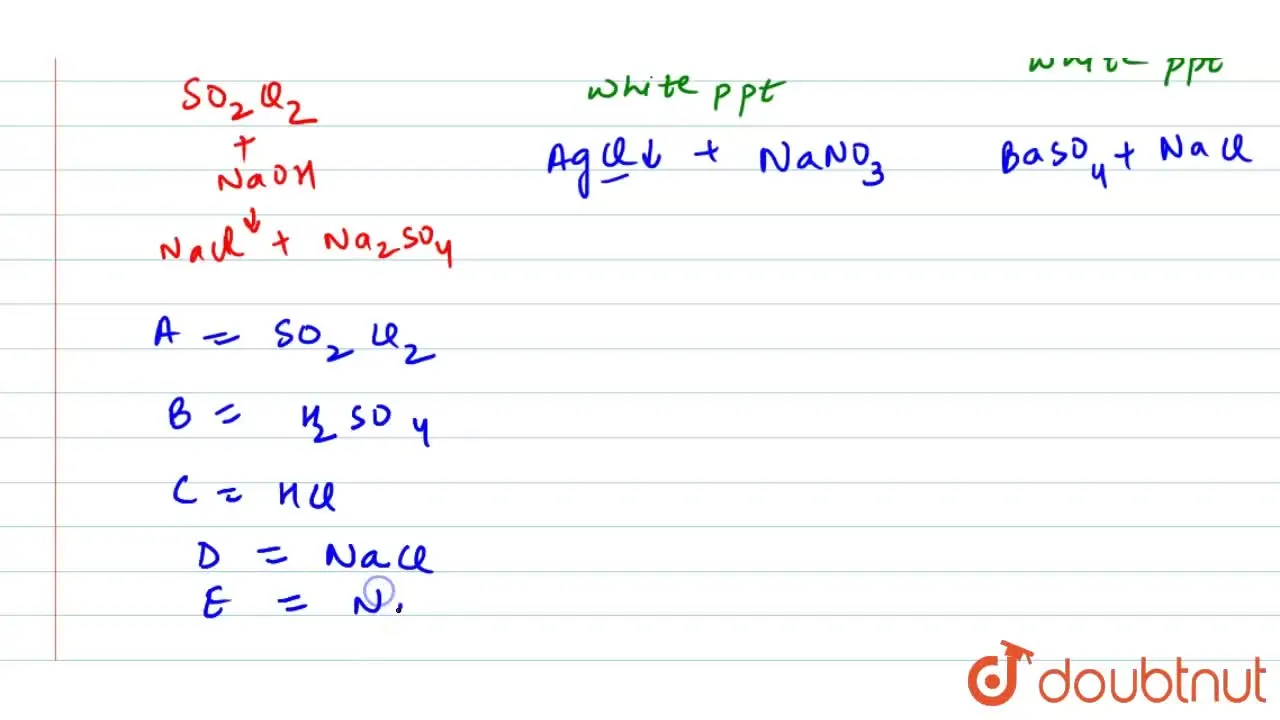An inorganic halide reacts with water to form two acids and also reacts with to form two salts and which remain in solution. The solution gives white precipitate with both and solutions respectively. is a useful organic reagent. Identify to .
White ppt
White ppt
gives white ppt. on reaching with ions, hence (D) is ,
gives white ppt. with ions, hence (D) is .
Hence (A) can be , since this on reacting with water gives acids namely and reacts with to form and
Both (D) and (E) are water soluble.
Hence is is and (E) is .
Related Playlists
- BOOK - CENGAGE CHEMISTRY ENGLISHCHAPTER - P-BLOCK GROUP 16 ELEMENTS - THE OXYGEN FAMILYEXERCISE - Ex 3.1Objective (Choose The Correct Option)11videos
P-BLOCK GROUP 16 ELEMENTS - THE OXYGEN FAMILY
- BOOK - CENGAGE CHEMISTRY ENGLISHCHAPTER - P-BLOCK GROUP 16 ELEMENTS - THE OXYGEN FAMILYEXERCISE - Exercises (Linked Comprehension)23videos
P-BLOCK GROUP 16 ELEMENTS - THE OXYGEN FAMILY
- BOOK - CENGAGE CHEMISTRY ENGLISHCHAPTER - P-BLOCK GROUP 16 ELEMENTS - THE OXYGEN FAMILYEXERCISE - Solved Example5videos
P-BLOCK GROUP 16 ELEMENTS - THE OXYGEN FAMILY
- BOOK - CENGAGE CHEMISTRY ENGLISHCHAPTER - P-BLOCK GROUP 15 ELEMENTS - THE NITROGEN FAMILYEXERCISE - Exercises Archives (Subjective)28videos
P-BLOCK GROUP 15 ELEMENTS - THE NITROGEN FAMILY
- BOOK - CENGAGE CHEMISTRY ENGLISHCHAPTER - P-BLOCK GROUP 17 ELEMENTS - THE HALOGEN FAMILYEXERCISE - True/False (Subjective)14videos
P-BLOCK GROUP 17 ELEMENTS - THE HALOGEN FAMILY
Similar Questions
Give an example of reaction where Two compounds in solution form gives white precipitate.
View SolutionWhich of the gives a white precipitate with a solution of AgNO3, a white precipitate with dil H2SO4 and a green flame test ?
View SolutionColourless salt (A) decolourise I2 solution and gives white precipitate (change to black) with AgNO3 solution. (A) also produces pink colour with FeCl3 solution. Identify (A) and explain reactions.
View SolutionWhich of the following anion does not prodcue prepitate with BaCl2 solution however gives precipitate with AgNO3?
View SolutionA white substance (A) reacts with dilute H2SO4 to produce a colourless suffocating gas (B) and a colourless solution (C )/ The reaction of gas (B) with potassium iodate and starch solution produce a blue colour solution. Aqueous Solution of (A) gives a white precipitate with BaCl2 solution which is soluble in dilute HCl. Addition of aqueous NH3 or NaOH to (C ) produced first a precipitate which dissolves in excess of the respective reagent to poduced a clear solution. Similarly addition of excess of potassium ferrocyanide to (C ) produced a precipitate (D) which also dissolves in aqeous NaOH giving a clear solution. Identify (A),(B),(C ) and (D ). Write the equation of the reactions involved.
View SolutionAn octahedral complex with molecular composition M.5NH3.Cl.SO4 has two isomers. A and B. The solution A gives a white precipitation with AgNO3 solution and the solution of B gives white precipitate with BaCl2 solution. The type of isomerism exhibited by the complex is :
View SolutionA gas 'X' is passed through water to form a solution. The aqeous solution on treatment with AgNO3 solution gives a white precipitate. The sturated aqueous solution also dissolves magnesium ribbon with the evolution of colourless gas 'Y'. Identify 'X' and 'Y'
View SolutionA salt solution of Cd2+ in dilute HCl, on treatment with a solution of BaCl2 gives a white precipitate, which is insoluble in concentrated HNO3. Anion in the salt may be :
View SolutionAn inorganic compound (X) shows the following reactions :
(a) It is white solid, exists as dimer and fumes in moist air.
(b) It sublimes at 180∘C and forms monomer on heating to 400∘C.
( c) Its aqueous solution turns blue litmus red and gives a white precipitate with AgNO3 solution which is soluble in excess of NH4OH.
(d) Addition of NaOH to the solution of (A) gives a white gelatinous precipitate which is, however, soluble on excess of NaOH.
Identify the compound (A).View SolutionA sulphide ore (A) on roasting leaves a residue (B). (B) on heating with chlorine gives (C), soluble in water, addition of excess potassium iodide to a solution of (C) gives a solution (D). A brown precipitate (E) is formed when a solution of ammonium sulphate is added to an alkaline solution of (D). Identify (A) to (E).
View Solution


